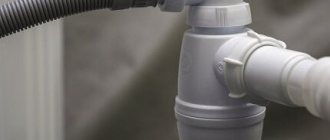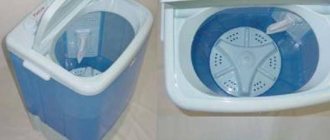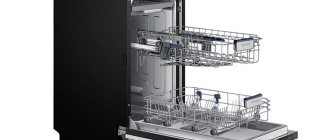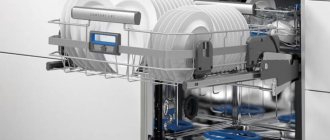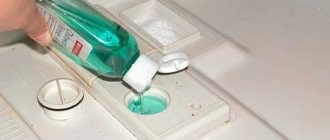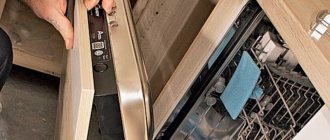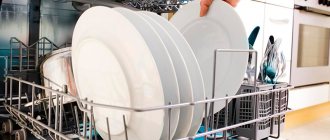There are quite a few PMM models for the kitchen. Moreover, each manufacturer of dishwashing equipment strives to stand out from the rest: some add various sensors to the design of the dishwasher, while others add new units with additional functions.
But, regardless of the brand, the general operating principle of a household-class dishwasher is the same. The main operating units of equipment under different brands are also similar. How does a dishwasher work and on what principle does it work? It is these questions that we will examine in detail in this material. We will also consider basic recommendations for operating dishwashers.
Dishwasher components
Most of the automatic dishwashers currently offered in stores are models built into kitchen units with frontal (vertical) loading of dishes. This technique simplifies the life of a housewife as much as possible.
I put dirty cutlery into the machine, pressed the button - and after a while the spoons, forks and plates were clean again.
Understanding the structure and operating principle of an automatic dishwasher is the key to 100% clean dishes at the end and a long service life of kitchen appliances
In order for the dishwasher to work properly and wash dishes thoroughly, the machine requires water, regenerating salt and detergents. In this case, the water jets must have a set temperature, the salt composition must meet the requirements for NaCl purity, and liquids and washing tablets must be suitable for the specific model.
Each dishwasher unit is responsible for its part of the dishwashing process. If the heating element does not heat the water sufficiently, the pump does not pump it completely, and the ion exchanger or filters become clogged, then the dishes will remain dirty. You will have to stand at the sink and finish the operation of the machine manually. But then why buy a dishwasher at all?
Main components of household PMM
The small body of the dishwasher contains the following working units:
- Circulation pump for water supply.
- Drain pump for pumping waste into the sewer.
- Ion exchanger with resin to soften hard water.
- Instantaneous water heater (heating element with safety thermostat).
- Temperature and liquid level sensors inside.
- Filter for cleaning wastewater from food residues.
- Filter for purifying water supplied to the machine.
- Internal washing chamber with several baskets for different dishes.
- Upper and lower sprinklers (rocker arms with nozzles).
- Display and operating mode selection panel.
- Control block.
Plus, some models are equipped with a heat exchanger, and some with a fan for drying washed dishes.
All the main operating components of the dishwasher are located in the lower part, under the washing chamber: water softening system (1), drainage water inlet with float (2), drain and circulation pumps (3, 4), control board (5) and water supply valve ( 6)
In most PMMs, one pump is used to supply water to the sprinklers and pump it into the drain; the operating mode of the pump in this case is regulated by a special valve
The chamber for dishes is made of stainless steel. To reduce noise, a rubber seal runs along the contour of the hatch door. The cutlery trays are made removable. This allows you to place not only small dishes inside the dishwasher, but also more frying pans or pots.
On the door there is a container for detergent (liquid, powder or tablets). Another reservoir is made at the bottom of the chamber - this is for regenerating salt in the ion exchanger.
On the front of the dishwasher there are machine status indicators or a display, as well as a touch or mechanical control panel. The display-touch version is the most convenient to use, but also the most expensive. At the same time, simpler mechanics in the form of a round handle will last much longer in the vast majority of cases.
The dishwasher has its own basket for each type of dishes - it protects kitchen utensils and glassware from breaking, and also ensures they are washed more thoroughly
A typical dishwasher also includes:
- power cable;
- hoses for draining dirty water and supplying clean water;
- shelves, baskets and trays for dishes.
Special salt and cleaning compounds are consumables. They are not included in the kit, but you should not turn on the dishwasher without them.
Water alone still won’t wash dishes well. Plus, the automatic dishwasher is initially configured to have these products inside. If there are none or they are in insufficient quantities, the machine will not work and the protection will work. We have provided recommendations for choosing the most effective dishwasher detergent in this publication.
Additional elements and devices
The operation of the PMM is controlled by the corresponding automation unit. It sends signals to pumps, heating elements and valves. However, he needs sensors that monitor what is happening inside the operating equipment. And here each manufacturer himself determines the required set of sensors.
There is always one sensor in the car - a water temperature meter. Without it, it is impossible to maintain the proper temperature in the washing chamber. Plus, he also makes sure that the heating element does not overheat.
Also, an automatic dishwasher may have sensors for the composition of the water (the degree of hardness and the presence of impurities in it), the air temperature in the kitchen, as well as the amount of salt and rinse aid in the washing solution
All these sensors are needed to improve the efficiency of the automatic PMM. The more the control unit knows about what is happening inside the chamber with the dishes, the better it is able to select the washing mode.
How is dishwasher drying implemented?
Another additional unit is associated with drying washed cutlery. Almost all models of such machines require such a function. Only the most inexpensive options come without this option.
To dry dishes, the dishwasher is equipped with:
- heat exchanger;
- fan with heating coil;
- block with zeolite.
The first option is a plastic tank inside the PMM. It is filled with cold water and, through simple heat exchange processes, removes excess moisture from the chamber when needed.
After washing is completed, water begins to evaporate from the dishes and settle in the form of condensation just on this heat exchanger and the inner walls of the washing machine. The process is quite lengthy, but such a unit does not require electricity to operate.
The second option is energy dependent, but dries dishes much faster. However, the spinning fan is a little noisy. When choosing a dishwasher with it, you need to make sure that the seal on the hatch performs not only the functions of preventing leaks, but also sound insulation. The lid should close as tightly as possible.
The third option is a new product of the latest generation, which not all manufacturers have in their lineup yet. When absorbing water, the zeolite mineral heats up and releases heat in the form of dry heated air.
This hot air flow is used to dry washed kitchen utensils. Such equipment consumes almost a third less electricity than its counterpart with a fan. Moreover, there is no need to change or add zeolite. It gradually recovers itself and gets rid of excess moisture.
Another interesting function is the projection of the time until the end of washing or simply a red “bunny” from a laser pointer when the unit is operating on the floor covering in the kitchen. The absence of this option is not critical, but its presence simplifies control over the PMM from afar
Dishwasher manufacturers are constantly adding new options to their models to attract buyers. The search for solutions to improve the efficiency of this technology is ongoing. Moreover, the more such additional modules, the greater the likelihood of PMM failure.
We examined each of the main working units in more detail in our article: The structure of a typical dishwasher: design, purpose and maintainability of various parts.
The importance of salt ion exchange
A distinction must be made between detergent and regenerating sodium salt for PMM. These are two different formulations that are poured into different dishwasher containers. “Soap” goes into a reservoir on the lid, and “sodium” is poured into a container at the bottom of the washing chamber.
There are also all-in-one tablets. They are placed in a compartment on the machine hatch and already contain the required volumes of saline solution. But if the water in the tap is very hard, with a high content of magnesium and calcium, then it will be difficult to do without salt specially designed for the ion exchanger. Without it, the PMM will inevitably and quite quickly break down in such a situation.
Special salt in the dishwasher softens water, improves the quality of cleaning dishes and relieves heating elements from limescale, and cutlery from white calcium deposits.
The PMM contains an ion exchanger with a resin consisting of sodium chloride NaCl. The entire flow coming from the water supply for washing first passes through this block, where calcium and magnesium in the water are replaced by sodium ions. As a result, the formation of scale on the parts of the dishwasher and stains on the dishes is eliminated.
Gradually Na is washed out of the ion exchanger and must be replaced with a new portion. Moreover, you cannot use a regular food analogue for this. As a last resort, it is permissible to use coarse-crystalline boiled salt of the “EXTRA” group. But it is best to use only formulations specially prepared for dishwashers with a NaCl content of more than 99%.
The rate of salt consumption is determined by the dishwasher settings. In many PMM models, this process must be adjusted manually using a special table. Moreover, during further operation you will have to constantly monitor the composition of the water and adjust the adjustment.
To save yourself from such a routine, immediately upon purchase choose equipment with a hardness sensor. This way the machine will adjust itself, and NaCl consumption will be as economical as possible. We have provided more recommendations for choosing a dishwasher here.
Description of the processes occurring in the dishwasher
At first glance, the dishwasher is difficult to operate and contains many incomprehensible functions. In fact, this is a fairly simple device that is easy and simple to use. Just a superficial study of the functionality of the dishwasher is enough to understand the system. You also need to figure out how to properly turn on your dishwasher for the first time.
The dishwasher is controlled using buttons. First, press the wash mode selection button, then the “start” button. Next, the machine itself will complete the tasks assigned to it. You can go about your business, since it turns off itself as soon as the time comes to complete the cycle.
So, the machine is turned on. Now the equipment works strictly according to the instructions contained in it. The control unit independently switches commands and cycles, after which the water intake valve opens and tap water begins to flow into the tank.
Note! It is necessary that the dishwasher be connected using hoses to the tap water sources. All necessary components are included with the device itself.
As soon as the water is taken, mixing with special salt begins. This procedure is necessary to reduce water hardness and prevent scale formation on pipes. In addition, softened water washes dishes more effectively. At the same time, the water heating element is activated. The user can independently set the desired temperature and steam strength.
Attention! Some types of dishes are especially susceptible to water temperature and alkalis contained in dishwasher refill “tablets”.
Now it all depends on what program you installed. The washing duration and steam intensity depend on the type of programs and cycles. Let's say we insert trays and place dishes. For example, when the soaking mode is turned on, the circulation pump begins to rotate. During this process, gradually, in small portions, the pump scatters water mixed with alkali onto the surface of the loaded plates, pots and spoons. All this is necessary so that, in the process of entering into a chemical reaction, due to gradual heating, the dried dirt will become acidic. After this, the dishes will be much easier to wash.
The next stage is the primary rinsing mode. This is one of the main elements of any dishwasher cycle. The pump now delivers water mixed with the product into the sprayer, after which the acidified particles begin to be washed away from the dishes. The spray arm has the shape of a screw, and during the rotation process it fills the entire cavity of the dishwasher with small particles of water. Thanks to this system, all loaded items receive the mixture. This helps to completely wash away any dirt remaining on the surface of the dishes. From now on the plates are clean, all that remains is to rinse and dry them.
Next comes water filtration. It is not dumped, but goes back into the tank, after which all dishes are rinsed and re-treated with dishwashing detergent. This is the control stage.
The next step is for the machine to begin self-cleaning. All dirty water goes down the drain, and the system re-injects some water to flush the tank and rinse the dishes. This is necessary to wash off any remaining product.
The last stage is drying. A special screw accelerates the air, heating it to the desired temperature, which allows it to successfully dry all plates and pots.
This is how a dishwasher works. Perhaps this description seemed heavy and difficult to digest for some. In this case, you can find visual aids in the form of video instructions for operating dishwashers. In this case, you can also additionally learn safety rules, find out the causes of dishwasher malfunctions and how to avoid breakdowns in the early stages.
How dishwashers work
To understand how a dishwasher works inside, you do not need to have any special knowledge of high sciences. The operation of an automatic dishwasher is based on the principle of a step-by-step process - first one cycle is performed, then the second, third, etc., and at the end clean cutlery is taken out of the machine.
Salt, water and detergents - these are the three components, as a result of mixing which dirty dishes are cleaned using a similar technique
Washing dishes in a PMM occurs in four stages:
- Pre-soaking (rinsing off large food residues).
- Main washing cycle.
- Rinse.
- Drying.
First, large remnants of uneaten food are removed from the surface of the dish. Then the temperature in the PMM increases and the main washing begins with the addition of detergents. This happens cyclically - collecting and heating water, spraying it around the chamber, draining it into the drain. The number of repetitions of this process depends on the selected washing mode. We talked in more detail about the washing cycle and the duration of the main modes in this material.
Depending on the selected mode, the water temperature in the PMM can reach 65–70 °C, but with an economical operating option it rarely rises above 50 °C, which significantly reduces the electricity consumption of the heating element
Finally, the dishes are rinsed with clean water and dried. If the machine comes with a heat exchanger, then the last stage may take several tens of minutes. If you have a drying fan or a module with zeolite, this happens much faster.
To ensure that water washes all parts of the dishes folded for washing, without exception, the sprinklers constantly rotate during operation. These rocker arms have several nozzles directed to the sides at different angles. The more nozzles there are and, accordingly, the number of jets in the chamber, the faster and more thoroughly the cutlery is washed.
DEVICE AND EQUIPMENT OF THE DISHWASHER
Any dishwasher is standardly represented by a set of elements and mechanisms that ensure its optimal and proper functioning. The design of dishwashers is quite similar.
The main mechanisms and components of the machine include:
–Main control menu:
it is usually located at the front, at the top of the car. It includes machine control functions, such as: display - can be touch or push-button, time timer, a set of buttons for turning on and off, as well as for additional modes. In the photo below we can see an example of a control panel:
– Motherboard
, which is soldered to the processor. It serves so that programs can be read and the machine correctly understands the command and control over it. In the photo below we can clearly see:
– Engine
, usually an electric one, which powers the entire dishwasher system. So to speak, this is her “heart”. In the photo below we can clearly see:
–
Detergent dispenser
, which is usually located on the door from the inside of the machine. In the photo below we can see it clearly:
– Special air path
. It is necessary for drying the cleaning elements. In the photo below we can clearly see:
–
Roaches
, which distribute the supply of detergent and water to the working surface of the machine. In the photo below we can clearly see:
– Special baskets
, which are necessary for loading elements that need washing into them. In the photo below we can clearly see:
–
A set of filters
,
a humidifier
and
a liquid softener
. Working together and at the same time, these mechanisms ensure water purification, as well as its preparation for washing. In the photo below we can clearly see:
–
Pump
, which provides supply and pumping of water from the water supply system into the machine. In the photo below we can clearly see:
– Bottom
and
drainage system
, which makes it possible to drain waste liquid into a sewer hose. In the photo below we can clearly see:
–
Heating element
, which ensures water heating to a level determined by the software. In the photo below we can clearly see:
–
Pendulum counterweight
, which provides strength and stability to the machine during operation. In the photo below we can clearly see:
–
Water supply mechanism
, which ensures regulation of the required volume of water consumption. In the photo below we can clearly see:
– Capacitor
ensures that the machine engine starts and runs smoothly. In the photo below we can clearly see:
–Water blowers
, which provide water under pressure into the machine system. In the photo below we can clearly see:
– Resin tank
, which softens the water entering the machine. In the photo below we can clearly see:
–
Reservoir for salt
, which also provides water softening. In the photo below we can clearly see:
–
Leakage regulator
, which provides and controls the machine’s leakage protection. In the photo below we can clearly see:
–
A pipe with a drain hose
, which ensures the discharge of waste water from the dishwasher into the sewer. In the photo below we can clearly see:
In the photo below we also tried to clearly demonstrate what all the elements of a dishwasher look like on a scale:
Rules for using a household dishwasher
Tablets, liquids and powders intended for dishwashers contain a minimum of foaming components. The abundance of foam only harms the process of washing dishes in the PMM. The less it is, the better. Therefore, you cannot use regular soap or anything similar in the dishwasher.
When placing dishes in the basket, you should make sure that they do not lie close to each other - this way the spray jets will not be able to hit closed surfaces and will not wash away all food residues
Not all cutlery can be washed in the PMM. Drying with hot air is contraindicated for plastic. The plate from it will at least soften, and maybe “leak” with plastic drops. In the latter case, the machine will most likely fail instantly.
Glasses and cups should be placed upside down in the basket. This will make it easier for streams from the sprinklers to get inside, plus most of the water will flow out of them by gravity.
And most importantly, nothing should interfere with the movement of the blades with nozzles. This will either break the dishes or damage the sprinklers. We provided detailed recommendations for operating a dishwasher in our other article.
If there are remnants of washed-out food left at the bottom of the washing chamber, this indicates a clogged drain filter. It needs to be cleaned regularly. But the fewer large pieces of food left on the dishes, the less often you will have to take it out and wash it, so it’s better not to be lazy in the beginning and carefully remove large leftovers from the plates.
Have you discovered that your dishwasher is clogged? In this case, we recommend that you familiarize yourself with DIY cleaning tips.
How the dishwasher works
All dishwashers have a closed front panel. You will not be able to observe the dishwashing process. You can control the operation only using the display readings. The light indication shows which cycle is currently running. Standard procedures have the following sequence: filling with water, mixing with detergents, heating it, washing cycles and drying.
During each operation, the dishwasher makes characteristic sounds that you can use to navigate.

